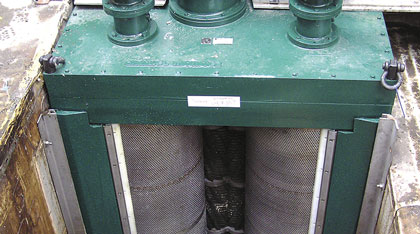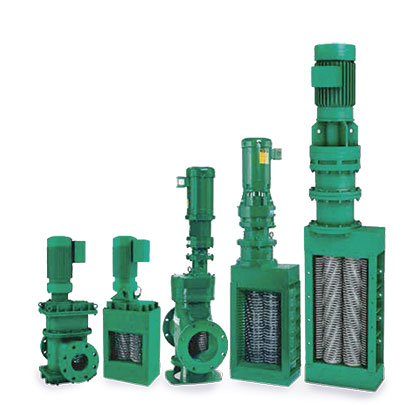Flushable wipes continue to inundate pump stations throughout North America, clogging both pumps and pipes and often requiring operators to remove the offending debris by hand. This deragging process is time-intensive, hazardous, and unfortunately, never completely finished, since new debris continuously flows into pump stations. Total shutdown, cleanout and rebuild of the pumps may be a weekly requirement for operators depending on the volume of wipes present in the waste stream.
According to a 2013 report done by the Association of the Nonwoven Fabrics Industry, wipes usage will grow 16 percent year-over-year in North America alone (INDA; Cary, North Carolina), meaning wipes will continue to pose significant problems in sewers, at water resource recovery facilities (WRRFs) and in pump stations. Chopper pumps and dual-shafted grinders both provide an economical, reliable solution for preventing clogs and equipment failure caused by wipes and nondispersibles. Pump station owners, however, should fully understand the significant differences between how the products are designed and handle debris before they make a final design decision. Equipped with this information, pump station owners will be successful in ending the clogs and equipment failure caused by wipes and nondispersibles.
DESIGN AND OPERATION
Dual-shafted grinders employ low-speed, high-torque grinding to break down troublesome solids. This configuration has always done well with tougher items like wood or rocks but it has also proven to be especially effective in shredding rags and consumer wipes when compared to single-shafted grinders or macerators. As the name indicates, dual-shafted grinders comprise two stacks with rows of hardened, steel cutters that rotate toward one another. The cutter teeth actively grab solids and pull them through the cutter stack, shredding solids into smaller pieces. The shafts rotate at different speeds, so the cutters interact like a pair of scissors—slicing the solids rather than crushing them. This slicing action helps ensure a consistently small particle size—most pieces are a ½-inch or smaller.
Dual-shafted grinders employ top and bottom shaft bearings and robust mechanical seals to prevent shaft deflection or seal failure when grinding high volumes of solids, like wipes, rags, and organics.
An in-line, dual-shafted grinder system comes in two parts, ensuring an efficient and streamlined installation. The flanged steel housing is bolted into the pipeline at both ends, and a removable cutter cartridge—including two shafts of cutters, the gear reducer and motor—slides down into the housing. This simplifies maintenance inspections and repairs by allowing the pipeline to be put back into service when the cutter cartridge is removed.
Chopper pumps are motor-driven, centrifugal pumps that macerate incoming solids prior to pumping them. This configuration protects the pump component from clogging and maintains flow through the system. The chopper component comprises a cartridge seal to handle slurries and reduce material wrapping, impeller vanes, auxiliary cutters and impeller blades. The auxiliary cutters move against the sharp impeller blades to chop solids prior to entering the hydraulic parts of the pump. To accomplish this task, chopper pumps employ high speed and low torque to both quickly chop and move solids.
Yet unlike a grinder, chopper pumps are not as efficient at handling large volumes of tough solids. This condition is a common occurrence in a pump or lift station near the end of a series of stations. Chopper pumps are required to operate at a relatively high speed to maintain the ability to pump fluids. This reduces the maximum possible torque which is required to successfully grind through solid debris like rocks, wood, plastics and rag balls caused by wipes. Chopper pumps are also limited by the type and volume of waste they can handle based upon their design—if the chopper doesn’t work, the unit can’t pump effectively, and therefore clogs. Adversely, a dual-shafted grinder isn’t required to maintain flow or move material through the entire system. The main function of a dual-shafted grinder is just that—grind any debris it makes contact with. This allows the continual flow of waste through the pump station providing the pumps the opportunity to do what they were intended to do–pump.

Featured Image: Dual-shafted grinders employ low-speed, high-torque grinding to break down troublesome solids.
Above: The patented Channel Monster utilizes rotating drums to capture solids in the channel. This unique design results in a high flow capacity system that will shred rags, rocks, wood, and other trash into small pieces. Debris passes harmlessly through pump stations, pipes, and process systems—lowering the total cost of system operations.
SELECTION CRITERIA AND POSITIONING
Despite the inherent limitations of chopper pumps, they can be effective if placed at the first of a series of lift or pump stations. If incorporated at an initial upstream point, the chopper pump is only handling the onset of waste from individual houses, buildings or apartment complexes from a localized area. Most of this initial debris is easily handled by a well-designed chopper pump.
As rags pass through collections systems in either long trunk lines or in a series of pump stations they tend to form “ropes” or rag balls as they recombine with hair and grease. When chopper pumps are placed further downstream in a series of stations, especially last in a line of pump stations, the enormous volume of rag balls and wipes that have accumulated create significant challenges. Dual-shafted grinders don’t experience this same limitation, regardless of where one is placed within a line of pump stations, due to their rugged construction and the torque of their cutting force.
DUAL-SHAFTED GRINDERS IN ACTION
The Otter Creek Water Reclamation District (South Elgin, Illinois) faced mounting reoccurring maintenance and cleanup costs at their Thornwood lift station due to a build-up of rags, wipes, trash, wrappers, and other debris clogging the system and forcing pump shutdowns. Thornwood is the largest of the district’s three lift stations, with an incoming flow of about 490 gallons per minute. The station’s three 40 horsepower (30 kW) pumps need to move sewage at about 600 gallons per minute at 36 feet TDH. Incoming debris would clog the pumps and force the district to take the system offline. Operators would then have to disassemble the pumps to clear the build-up by hand, reassemble them, and restart the system. The district engineer noted that the facility was seeing higher volumes of polyester-reinforced rags, which seemed to be a significant factor increasing clogging.
This build-up was so massive that, beyond regular cleanings by the operators, the station was forced to hire a Vactor truck four times a year at $4,900 a visit to remove rags and wipes from the wet well. In addition, the weight from the debris build-up would disconnect the cables leading to the submersible pumps, inadvertently shutting off and short-circuiting them. Altogether, the cost to deal with these maintenance and repair issues was costing the district almost $20,000 a year in hard costs plus the additional maintenance time.
The district engineer suggested a dual-shafted grinder unit, an in-channel Muffin Monster® from JWC Environmental. Since the installation of the grinder in 2012, the lift station has had zero pump maintenance issues and eliminated the previous costs associated with clogging problems.
LONG-TERM INVESTMENT
As the Thornwood Lift Station example demonstrates, properly selected equipment can provide pump stations with exponential cost savings and reduce unscheduled maintenance. The initial investment in a dual-shafted grinder or chopper pump may deter some end users from incorporating a solution within their system. Although, when wastewater districts compare the up-front cost with the long-term benefits of a solving the wipes problem for their pump or lift stations, the return on investment makes the choice easy.
While end users can’t totally eliminate the impact of wipes and nondispersibles on influent waste streams in their pump station, they can dramatically improve the clogging and ragging situation with the right waste reduction equipment. While chopper pumps are effective solutions at initial upstream pump stations, there is no comparison to the benefits, both immediate and long-term, that a well-engineered dual shafted grinder offers throughout the wastewater system. ◆
Since its founding in 1973, JWC Environmental has become a world leader in solids reduction and removal for the wastewater industry with its Muffin Monster® grinders and Monster screening, compaction and washing systems. JWC also solves challenging size reduction and processing problems in commercial and industrial applications with its Monster Industrial® products. JWC Environmental is headquartered in Costa Mesa, California, and has a global network of representatives, distributors and regional service centers to provide customer support. For more information, visit www.jwce.com.
____________________________________________
MODERN PUMPING TODAY, September 2017
Did you enjoy this article?
Subscribe to the FREE Digital Edition of Modern Pumping Today Magazine!
![]()


